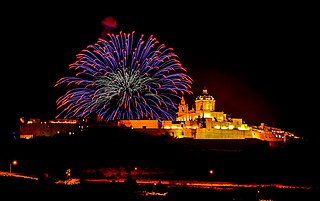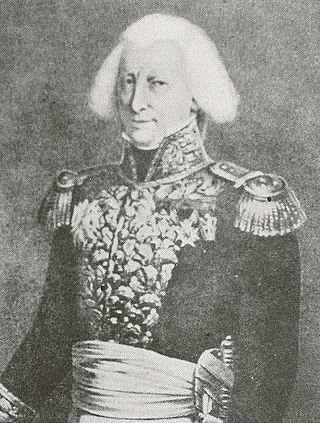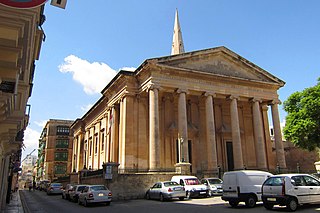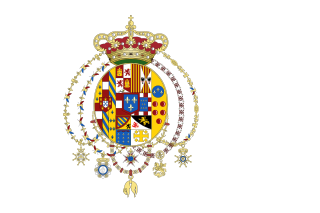This article details the history of religion in Malta. The Republic of Malta is a Southern European country consisting of an archipelago situated in the centre of the Mediterranean, 80 km south of Sicily, 284 km east of Tunisia and 333 km north of Libya, with Gibraltar 1,755 km to the west and Alexandria 1,508 km to the east. Malta covers just over 316 km2 in land area, making it one of the world's smallest states. It is also one of the most densely populated countries worldwide. Catholicism is the official religion in Malta as declared by the Maltese constitution.
Starting from around 3600 BC, Malta passed through a "temple period" which saw the construction of structures tied with religious beliefs such as the Ggantia temple Gozo (the "Ggantia phase" between 3600 and 3200 BC), the Hypogeum (the "Saflieni phase" between 3300 and 3000 BC) and the Tarxien temples, Hagar Qim and Mnajdra (the "Tarxien phase" between 3150 and 2500 BC). Fertility rites were probably the religious practices at these sites.
Catacombs in Rabat testify to an early Christian community in Malta. The Acts of the Apostles tells the story of how Paul of Tarsus was shipwrecked in Malta on his way from Caesarea Maritima to Rome, sent by Porcius Festus, procurator of Judea, to stand trial before the Emperor. Paul ministered in Malta for three months (Acts 28:1–11).
According to tradition, Publius, the Roman Governor of Malta at the time, became the first Bishop of Malta following his conversion to Christianity. His episcopate is said to have lasted thirty-one years before facing martyrdom in Greece.
There is scant information about the continuity of Christianity in Malta in subsequent years although tradition has it that there was a continuous line of bishops from Publius to the time of Emperor Constantine. The Acts of the Council of Chalcedon record that, in 451 AD, a certain Acacius was Bishop of Malta (Melitenus Episcopus) and in 501 AD, a certain Constantinus, Episcopus Melitenensis, was present at the Second Council of Constantinople. In 588 Tucillus, Miletinae civitatis episcopus, was deposed by Pope Gregory I and his successor, Trajan, was elected by the clergy and people of Malta in 599 AD. The last recorded Bishop of Malta before the Arab invasion was a Greek by the name of Manas, who was subsequently incarcerated in Palermo. [1] Under the Arab occupation, the native Christians were allowed freedom of religion but had to pay jizya. [2]
The Normans relieved Sicily and the Maltese Islands in 1091 [3] and Roger I of Sicily was warmly welcomed by the native Christians. [3]
The Jewish population of Malta reached a peak in the Middle Ages under Norman rule, which began in 1090, with 500 living on the main island and 350 on Gozo. The medieval Jewish kabbalist Abraham Abulafia escaped persecution in Sicily and fled to Malta. He died on the tiny island of Comino, in the 1290s.
In 1479, Malta and Sicily came under Aragonese rule and the Alhambra Decree of 1492 forced all Jews to leave the country with only a few belongings. Several dozen Maltese Jews may have converted to Christianity in order to be able to remain in the country. A Jewish subculture re-emerged in Malta during the reign of the Knights Hospitaller.
While the Maltese Islands were under the dominion of the Knights of Malta, from the 15th century through to the late 18th century, the Grand Master had the status of a prince of the Catholic Church, and enjoyed a special relationship with the Pope, which occasionally led to a considerable amount of friction with the local Bishops.
Over the years, the power of the Knights declined and the Order became unpopular. This was around the time when the universal values of freedom and liberty were incarnated by the French revolution. People from both inside the Order and outside appealed to Napoleon Bonaparte to oust the Knights. The Little Corporal did not hesitate. His fleet arrived in 1798, en route to his expedition of Egypt. As a ruse towards the Knights, Napoleon asked for safe harbour to resupply his ships, and then turned his guns against his hosts once safely inside Valletta. Grand Master Hompesch capitulated, and Napoleon entered Malta.
During his very short stay (six days), he accomplished quite a number of reforms, notably the creation of a new administration with a Government Commission, the creation of twelve municipalities, the setting up of a public finance administration, the abolition of all feudal rights and privileges, the abolition of slavery and the granting of freedom to all Turkish slaves. On the judicial level, a family code was framed and twelve judges were nominated. Public education was organised along principles laid down by Bonaparte himself, providing for primary and secondary education. Fifteen primary schools were founded and the university was replaced by an ’Ecole centrale’ in which there were eight chairs, all very scientific in outlook: notably, arithmetic and stereometry, algebra and stereotomy, geometry and astronomy, mechanics and physics, navigation, chemistry, etc. He then sailed for Egypt leaving a substantial garrison in Malta. However when, within months, the French began closing convents and seizing church treasures the Maltese people rebelled, and the French garrison of General Claude-Henri Belgrand de Vaubois retreated into Valletta. After several failed attempts by the locals to retake Valletta, they asked the British for assistance. Rear Admiral Lord Horatio Nelson decided on a total blockade, and in 1800 the French garrison surrendered.
In 1814, Malta became part of the British Empire in accordance with the Treaty of Paris. British rule lasted 150 years until 1964 when Malta gained independence and brought the first sizeable population of members of the Anglican church and other Protestant denominations. From 1815 to 1820, the Anglican missionary William Jowett of the Church Missionary Society based his Mediterranean Mission in Malta. [4]
British colonial administration, however, continued to show respect and deference towards Maltese Catholic customs. The situation also led to the emergence of a small population of Catholics of British and Irish origin in Malta.
Historically part of the Diocese of Malta, Gozitans brought forward several petitions for the creation of an independent diocese, including in 1798, during the French occupation, and again in 1836. A third petition, brought directly to Pope Pius IX in 1855, met with success. Instrumental in this effort were a young priest named Don Pietro Pace, who would several years later serve as Bishop of Gozo, and Sir Adriano Dingli, Crown Advocate. The British Colonial Office signalled its approval in October 1860. [5]
In 1863, Archpriest Michele Francesco Buttigieg was elected Auxiliary Bishop of Malta with instructions to reside in Gozo. One year later, on September 16, 1864, the Pope issued a Bull entitled "Singulari Amore" (With remarkable Love), which decreed that the Islands of Gozo and Comino were separated from the Diocese of Malta. On September 22, 1864, Bishop Buttigieg was elected the first bishop of Gozo, with the "Matrice" in Victoria, dedicated to the Assumption of the Blessed Virgin (Maltese: "Marija Assunta"), serving as his Cathedral. [5]
To this day there are two episcopal jurisdictions: the Archdiocese of Malta and the Diocese of Gozo.

Malta, officially the Republic of Malta, is an island country in Southern Europe, located in the Mediterranean Sea. It consists of an archipelago between Italy, Tunisia and Libya. It lies 80 km (50 mi) south of Sicily and Italy, 284 km (176 mi) east of Tunisia, and 333 km (207 mi) north of Libya. The two official languages are Maltese, the only Semitic language in Europe and the European Union, and English. The country's capital is Valletta.

Malta has been inhabited since 5900 BC. The first inhabitants were farmers; their agricultural methods degraded the soil until the islands became uninhabitable. The islands were repopulated around 3850 BC by a civilization that at its peak built the Megalithic Temples, which today are among the oldest surviving buildings in the world. Their civilization collapsed in around 2350 BC; the islands were repopulated by Bronze Age warriors soon afterwards.

The culture of Malta has been influenced by various societies that have come into contact with the Maltese Islands throughout the centuries, including neighbouring Mediterranean cultures, and the cultures of the nations that ruled Malta for long periods of time prior to its independence in 1964.

Claude-Henri Belgrand de Vaubois was a French general during the French Revolutionary Wars and the Napoleonic Wars. He is best known for the surrender of Malta to the British in 1800. On 20 August 1808 he was created Comte de Belgrand de Vaubois. Later, his name was inscribed on the Arc de Triomphe in Paris.

Qala is an administrative unit of Malta, on the island of Gozo, with a population of 1,929 as of September 2019. Nearby is Ħondoq ir-Rummien, a coastline with salt pans and caves.

The Archdiocese of Malta is a metropolitan archdiocese of the Latin Church of the Catholic Church in Malta.

The Diocese of Gozo is a Latin diocese of the Catholic Church in Malta, and the only suffragan in the ecclesiastical province of the Metropolitan Archdiocese of Malta, together covering the insular state.

Catholic Christianity is the predominant religion in Malta. The Constitution of Malta establishes Catholicism as the state religion, and it is also reflected in various elements of Maltese culture.

Islam in Malta has had a historically profound influence upon the country—especially its language and agriculture—as a consequence of several centuries of control and presence on the islands. Today, the main Muslim organizations represented in Malta are the Libyan World Islamic Call Society.

The history of the Jews in Malta spans two millennia. A Jewish community is attested on the islands by the 4th-5th century. Jews prospered in Malta under Arab and Norman rule. They were expelled in 1492, and a community could only re-establish itself after 1798 under British rule. In the 19th and 20th century, the Jewish community in Malta welcomed refugees from Italy and Central Europe, escaping Nazi rule. Today, a small community remains well established on the islands.

St Paul's Pro-Cathedral, officially The Pro-Cathedral and Collegiate Church of Saint Paul, is an Anglican pro-cathedral of the Diocese in Europe situated in Independence Square, Valletta, Malta. A "pro-cathedral" is a church with cathedral status though not being the main cathedral. It is one of three cathedrals of the Anglican Diocese of Gibraltar in Europe.

In the small Mediterranean island nation of Malta, the predominant religion is Roman Catholicism.

The following outline is provided as an overview of and topical guide to Malta:

The Gozitan Nation, commonly known as Gozo, was an unrecognised state located on the island of Gozo between 1798 and 1801 during the French Revolutionary Wars. It was a monarchy recognizing the authority of Ferdinand III of Sicily with a provisional government led by Governor-General Saverio Cassar. Its capital was Rabat. The country was established between 28 and 29 October 1798 from the territory of French-occupied Malta and was eventually incorporated into Malta Protectorate on 20 August 1801.

The French occupation of Malta lasted from 1798 to 1800. It was established when the Order of Saint John surrendered to Napoleon Bonaparte following the French landing in June 1798. In Malta, the French established a constitutional tradition in Maltese history, granted free education for all, and theoretically established freedom of the press, although only the pro-French newspaper Journal de Malte was actually published during the occupation.

Hospitaller Malta, officially the Monastic State of the Order of Malta, and known within Maltese history as the Knights' Period, was a polity which existed between 1530 and 1798 when the Mediterranean islands of Malta and Gozo were ruled by the Order of St. John of Jerusalem. It was formally a vassal state of the Kingdom of Sicily, and it came into being when Emperor Charles V granted the islands as well as the city of Tripoli in modern Libya to the Order, following the latter's loss of Rhodes in 1522. Hospitaller Tripoli was lost to the Ottoman Empire in 1551, but an Ottoman attempt to take Malta in 1565 failed.

Saviour Montebello (1762–1809) was a Maltese Doctor of Theology, a professor of philosophy at the University of Malta, and a Parish priest of Bormla. After Napoleon took over the Maltese islands in 1798, Montebello took an active part in the resistance of the Maltese against the French around his home-town at Żejtun. Afterwards, when the French Napoleonic forces had been ousted, and the British set up a provisional government in Malta, he was the first to be appointed to the Chair of Philosophy at the University of Malta. He held the office for almost four years, mainly teaching logic and metaphysics. He relinquished the Chair because he was appointed parish priest of Bormla, the last to hold the office under this title because subsequently the parish was promoted to a Collegiate led by Archpriests. He held the office of parish priest for only five years due to his premature death at the age of 46.
Antonius Grech Delicata Testaferrata was a Maltese bishop who became the second Bishop of Gozo in 1868.

The French invasion of Malta was the successful invasion of the islands of Malta and Gozo, then ruled by the Order of St. John, by the French First Republic led by Napoleon Bonaparte in June 1798 as part of the Mediterranean campaign of the French Revolutionary Wars.
malta arab.